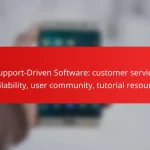Sales tracking software is essential for modern businesses, offering streamlined lead management, enhanced sales forecasting, and insightful performance metrics. By effectively capturing and nurturing leads, these tools enable sales teams to prioritize opportunities and improve conversion rates. Additionally, advanced features like predictive analytics empower teams to make informed decisions based on historical data and current trends, ultimately driving sales efficiency and revenue growth.
![]()
What are the best sales tracking software solutions?
The best sales tracking software solutions streamline lead management, enhance sales forecasting, and provide valuable performance metrics. These tools help sales teams track their progress, manage customer relationships, and make data-driven decisions to boost sales efficiency.
HubSpot Sales Hub
HubSpot Sales Hub is a comprehensive sales tracking software that integrates seamlessly with HubSpot’s CRM. It offers features like email tracking, meeting scheduling, and pipeline management, making it easier for sales teams to manage leads and forecast sales accurately.
One of its key advantages is the user-friendly interface, which allows teams to quickly adapt and start using the software without extensive training. Additionally, HubSpot offers a free tier, making it accessible for small businesses looking to enhance their sales processes.
Salesforce Sales Cloud
Salesforce Sales Cloud is a leading sales tracking solution known for its robust customization options and extensive integration capabilities. It provides tools for lead management, opportunity tracking, and detailed sales forecasting, making it suitable for businesses of all sizes.
Considered a powerful platform, Salesforce can handle complex sales processes and large datasets. However, its extensive features may require a steeper learning curve and higher costs, particularly for smaller companies or startups.
Pipedrive
Pipedrive is designed with a focus on sales pipeline management, allowing teams to visualize their sales processes easily. It features customizable pipelines, activity reminders, and reporting tools that help sales professionals stay organized and on track.
This software is particularly beneficial for small to medium-sized businesses due to its straightforward pricing model and ease of use. Pipedrive also offers integrations with various third-party applications, enhancing its functionality for sales teams.
Zoho CRM
Zoho CRM is an affordable sales tracking software that provides a wide range of features, including lead management, sales automation, and performance analytics. It is particularly appealing to small businesses due to its competitive pricing and flexible plans.
Zoho CRM allows for extensive customization, enabling businesses to tailor the software to their specific needs. However, some users may find the interface less intuitive compared to other platforms, which could require additional training for effective use.
Freshsales
Freshsales is a sales tracking solution that combines CRM capabilities with AI-driven insights. It offers features like lead scoring, email tracking, and built-in phone capabilities, making it a versatile tool for sales teams.
This software is particularly beneficial for businesses looking to leverage automation to enhance their sales processes. Freshsales provides a free trial, allowing teams to explore its features before committing to a subscription, which is ideal for evaluating its fit for your organization.
![]()
How does lead management work in sales tracking software?
Lead management in sales tracking software involves systematically capturing, scoring, and nurturing potential customers to optimize sales processes. This approach helps businesses prioritize leads, improve conversion rates, and ultimately increase revenue.
Lead capturing
Lead capturing is the initial step in the lead management process, where potential customer information is collected through various channels. Common methods include web forms, social media interactions, and email subscriptions. Utilizing automated tools can streamline this process, ensuring that no lead is overlooked.
Effective lead capturing should focus on gathering essential data such as names, email addresses, and phone numbers. Consider using incentives like discounts or free trials to encourage prospects to share their information.
Lead scoring
Lead scoring assigns values to leads based on their likelihood to convert, helping sales teams prioritize their efforts. This scoring can be based on demographic information, engagement levels, and behaviors, such as website visits or email opens. A typical scoring system might range from 1 to 100, with higher scores indicating more promising leads.
To implement lead scoring effectively, define clear criteria that reflect your ideal customer profile. Regularly review and adjust these criteria to align with changing market conditions or business goals.
Lead nurturing
Lead nurturing involves building relationships with potential customers through targeted communication and personalized content. This process is crucial for moving leads through the sales funnel, especially those who may not be ready to buy immediately. Strategies may include email marketing campaigns, educational content, and follow-up calls.
To nurture leads successfully, segment your audience based on their interests and behaviors. Use marketing automation tools to send timely, relevant messages that resonate with each segment, increasing the chances of conversion.

What features enhance sales forecasting?
Sales forecasting is significantly improved by features like predictive analytics, historical data analysis, and sales pipeline management. These tools help sales teams make informed decisions by analyzing trends, past performance, and current opportunities.
Predictive analytics
Predictive analytics uses statistical algorithms and machine learning techniques to identify the likelihood of future outcomes based on historical data. By analyzing patterns in customer behavior and market trends, businesses can forecast sales more accurately. For instance, a company might use predictive models to estimate sales for the upcoming quarter based on previous sales cycles.
To implement predictive analytics effectively, ensure you have access to quality data and the right analytical tools. Common pitfalls include relying on incomplete data sets or failing to adjust models based on changing market conditions.
Historical data analysis
Historical data analysis involves examining past sales data to identify trends and patterns that can inform future sales strategies. By understanding what has worked in the past, sales teams can make better predictions about future performance. For example, analyzing seasonal sales trends can help businesses prepare for peak periods.
When conducting historical data analysis, focus on key metrics such as sales volume, customer acquisition costs, and conversion rates. Regularly updating your analysis ensures that your forecasts remain relevant and accurate.
Sales pipeline management
Sales pipeline management is crucial for tracking the progress of leads through various stages of the sales process. By visualizing the pipeline, sales teams can identify bottlenecks and forecast revenue more effectively. For example, knowing how many leads are in the negotiation stage can help predict potential sales for the month.
To optimize sales pipeline management, regularly review and update the status of leads. Implementing a CRM system can streamline this process, allowing for better tracking and forecasting based on real-time data.
![]()
What performance metrics can sales tracking software provide?
Sales tracking software can provide crucial performance metrics that help businesses evaluate their sales effectiveness. Key metrics include conversion rates, sales cycle length, and revenue forecasting, each offering insights into different aspects of the sales process.
Conversion rates
Conversion rates measure the percentage of leads that turn into actual sales. This metric is vital for assessing the effectiveness of sales strategies and marketing efforts. A typical conversion rate can vary widely, often ranging from low single digits to over 20%, depending on the industry and sales approach.
To improve conversion rates, businesses should analyze their sales funnel and identify bottlenecks. Regularly reviewing lead sources and optimizing follow-up processes can enhance this metric significantly.
Sales cycle length
The sales cycle length refers to the time it takes for a lead to progress from initial contact to closing the sale. Understanding this metric helps businesses streamline their sales processes and improve efficiency. Sales cycles can vary from a few days for low-cost items to several months for high-value contracts.
To shorten the sales cycle, focus on nurturing leads effectively and addressing their concerns promptly. Implementing automated follow-ups and using CRM tools can help maintain engagement and reduce delays.
Revenue forecasting
Revenue forecasting involves predicting future sales based on historical data and current market trends. This metric is essential for budgeting and resource allocation. Accurate revenue forecasts can help businesses make informed decisions about staffing, inventory, and marketing investments.
To enhance forecasting accuracy, consider using a combination of historical sales data, market analysis, and sales team input. Regularly updating forecasts based on real-time data can also improve reliability and help adjust strategies as needed.
![]()
What criteria should be considered when selecting sales tracking software?
When selecting sales tracking software, consider integration capabilities, user interface, and pricing models. These factors directly impact how effectively the software can be utilized to manage leads, forecast sales, and measure performance metrics.
Integration capabilities
Integration capabilities determine how well the sales tracking software connects with other tools and platforms your business uses, such as CRM systems, email marketing software, and accounting tools. Look for software that offers seamless integration with popular applications to streamline workflows and enhance data sharing.
Evaluate whether the software supports APIs or third-party integrations, which can significantly expand its functionality. For example, a system that integrates with your existing CRM can automatically sync lead information, reducing manual data entry and minimizing errors.
User interface
A user-friendly interface is crucial for ensuring that your team can effectively utilize the sales tracking software. A clean, intuitive design helps users navigate the system easily, which can lead to higher adoption rates and better overall performance.
Consider conducting a trial or demo to assess the user interface firsthand. Look for features like customizable dashboards, easy-to-read reports, and straightforward navigation that can enhance user experience and productivity.
Pricing models
Pricing models for sales tracking software can vary widely, including subscription-based, one-time purchase, or tiered pricing based on features and user count. Assess your budget and the specific features you need to determine the best fit for your organization.
Some software may offer free trials or freemium versions, allowing you to test the product before committing financially. Be cautious of hidden costs, such as additional fees for integrations or premium support, which can affect your overall budget.
![]()
How can sales tracking software improve team performance?
Sales tracking software enhances team performance by streamlining lead management, enabling accurate sales forecasting, and providing insightful performance metrics. These tools help sales teams identify opportunities, prioritize leads, and make data-driven decisions that drive revenue growth.
Lead management
Effective lead management is crucial for maximizing sales opportunities. Sales tracking software organizes leads by source, status, and engagement level, allowing teams to focus on the most promising prospects. By automating follow-ups and reminders, teams can ensure timely communication, which significantly increases the chances of conversion.
Consider using a scoring system to prioritize leads based on their likelihood to convert. This approach helps sales representatives allocate their time efficiently, focusing on high-value leads while nurturing others through targeted campaigns.
Sales forecasting
Sales forecasting allows teams to predict future revenue and set realistic targets. Sales tracking software analyzes historical data and current trends to provide forecasts that help in strategic planning. Accurate forecasts enable businesses to allocate resources effectively and adjust strategies proactively.
To improve forecasting accuracy, ensure that your sales tracking software integrates with other business systems, such as CRM and marketing automation tools. This integration provides a comprehensive view of customer interactions and market conditions, leading to more reliable predictions.
Performance metrics
Performance metrics are essential for evaluating sales team effectiveness. Sales tracking software provides key performance indicators (KPIs) such as conversion rates, average deal size, and sales cycle length. By monitoring these metrics, teams can identify strengths and weaknesses, allowing for targeted improvements.
Establish a regular review process for performance metrics, such as weekly or monthly meetings, to discuss progress and adjust strategies as needed. This practice fosters accountability and encourages a culture of continuous improvement within the sales team.






